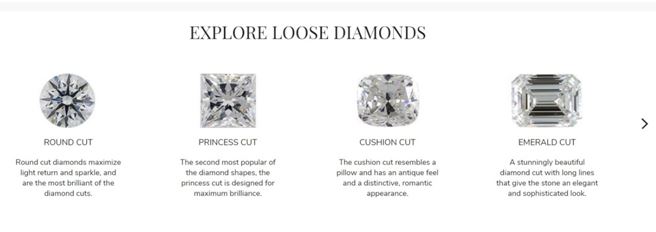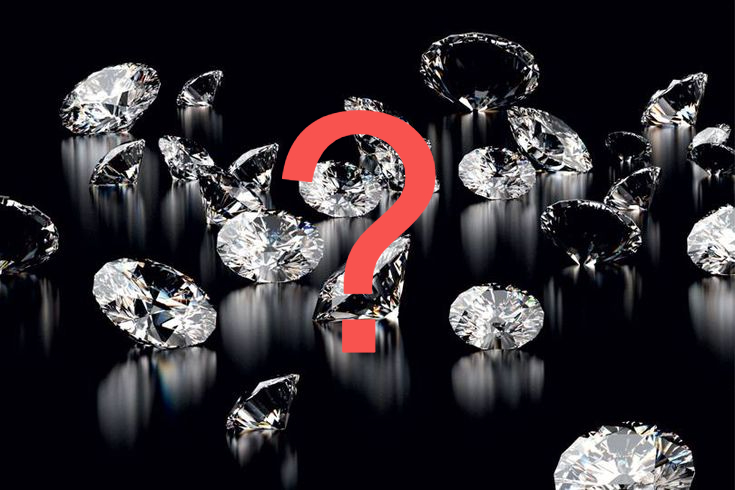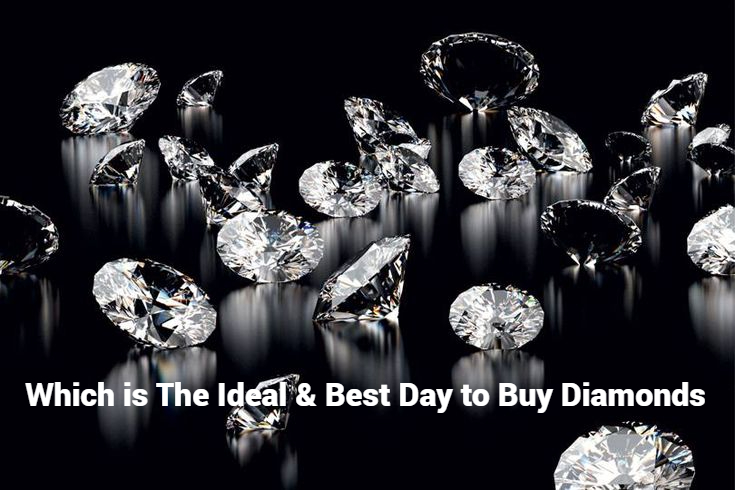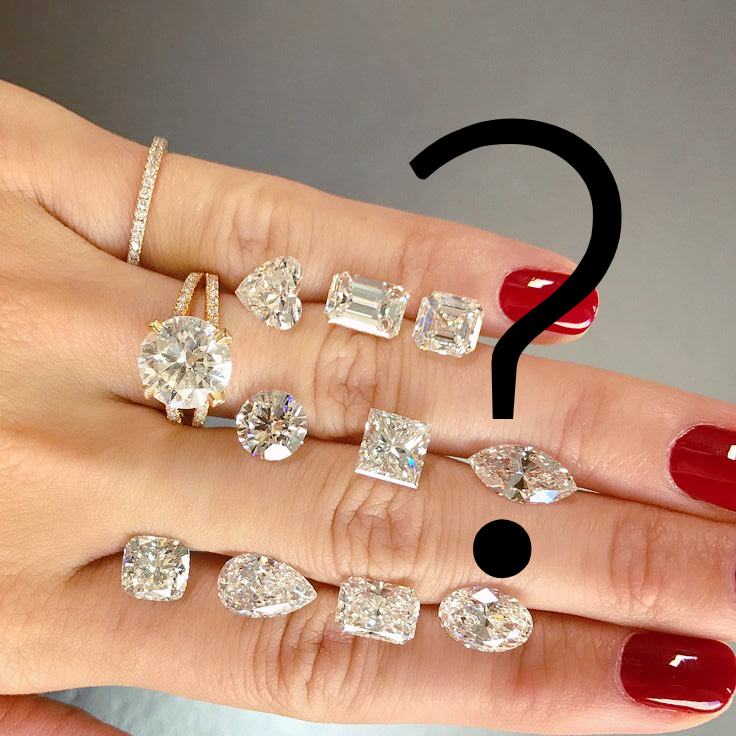- Introduction
- Definition of key terms:
- Reflection: Deflection of light away from a surface
- Refraction: Bending of light as it passes through a medium
- Critical angle: The angle beyond which all light would be reflected; it is 24 degrees in diamonds
- Fire: colorful flashes seen in diamonds due to the splitting of white light into its component colors.
- Scintillation: refers to the sparkle that is seen when diamonds are moved.
- Diamond brilliance is the life of diamonds. It refers to the inherent ability of a diamond to reflect or refract light.
- It determines how bright or dim a diamond would appear.
- There are five factors that affect diamond brilliance. They are:
- Diamond cut: refers to the interaction of the diamond with light. This is discussed under two subheadings.
- Type of cut:
- A brilliant-cut is one designed to reflect light optimally. The angles and facets are made in such a way that light is easily reflected.
- Other cuts like step cuts are not cut essentially for diamond brilliance. Some like the Asscher is cut for clarity.
- The quality of cut: The quality of cut would determine how well the diamond would reflect or refract light.
- Excellent: Would have the best diamond properties that could aid brilliance.
- Very good
- Good
- Fair
- Poor: Would have the least diamond properties that would promote diamond brilliance.
- Polish: It refers to the quality of the diamond facets after polishing is done.
- Polishing can be graded into:
- Excellent
- Very good
- Good
- Fair
- Poor
- When the diamond polish is poorly done, polish lines can blur the surface of the diamond and cause a reduction in the amount of light reflected in the diamond
- Poor polishing can also cause an irregularity in the direction of light, which would also negatively affect diamond brilliance
- Polishing can be graded into:
- Scintillation: refers to the sparkle seen when diamonds are in motion.
- Scintillation is observed when the light source, the observer or the diamond itself is moved.
- It can be divided into two:
- Flash scintillation: Refers to areas of light and dark sparkle that are seen when the diamond is in motion.
- It is caused by white and black lines that are present in the diamond
- It is seen under different types of lighting
- Fire scintillation: It refers to the colored sparkles that are observed when the diamond, light source or observer moves.
- It is caused by the splitting of white light into its various spectral components
- It is seen under white light
- It adds dynamism to the reflection that is observed in a diamond
- Flash scintillation: Refers to areas of light and dark sparkle that are seen when the diamond is in motion.
- Type of cut:
- Diamond cut: refers to the interaction of the diamond with light. This is discussed under two subheadings.
- Contrast: Refers to the separation of the white and dark lines in a diamond
- It relies heavily on diamond symmetry
- There are two types:
- Dynamic contrast: white and dark lines observed in motion, closely related to scintillation
- Static contrast: White and black lines observed when there is no relative or absolute motion.
- Contrast powers scintillation.
- Contrast allows for a renewed effect of brightness because of alternation with dark areas.
- Symmetry: refers to the precision to which all of the facets and other diamond proportions have been cut
- It is also considered as parameters considered in cut, but we examine it on its own here
- It is graded at 10x magnification into:
- Excellent, Very good, good, fair and poor
- Poor symmetry would cause light leakage and reduced diamond reflection
- Poor symmetry negatively affects diamond brilliance.
- All these factors should be considered in diamond brilliance
- View the diamond you want to buy personally, at different angles and under different lighting conditions
- Discuss with your gemologist if you get confused
INTRODUCTION
When you see a diamond for the first time, what comes to your mind?
Brightness? Sparkle? Scintillation?
Exactly.
This what most people would say when they view a diamond for the first time, and rightly so. Without these properties, your diamond would not be different from a regular piece of jewelry.
But thankfully, we have scintillation, we have fire and we have Brilliance!
These are features that would always create the wonderful visual effect that you see whenever you have an encounter with a diamond.
Diamond brilliance refers to the inherent ability of a diamond to reflect or refract (bend) light. It is what determines how bright or dim a diamond would be.
To understand this concept properly, let us examine some related terms.
- Reflection: This refers to the deflection of light away from a surface. So when light hits the surface of a diamond, it is reflected back to the eye of the observer.
- Refraction: It refers to the bending of light rays in simple terms. This feature is very important in the brilliance of a diamond. In refraction, light actually passes through the diamond, but only the direction is changed or bent, depending on the refracting angle. Light entering the diamond must be bent to reach appropriate surfaces.
- Critical angle: This is the angle beyond which all light would be reflected instead of refracted. The critical angle of the diamond is 24 degrees. This means that when light falls at an angle greater than 24 degrees on the diamond, a light would be reflected, not refracted. This is a very good quality of the diamond, meaning that the tendency to reflect light into the eye of the observer is very high. Diamond cutters exploit this quality to create bright and attractive diamonds.
- Fire: This refers to the colorful flashes of light which are observed in a diamond. These flashes are due to the dispersion of white light into its components colors, like Red, Orange, Yellow, green and so on. The fire of a diamond is an important part of its brilliance.
- Scintillation: This refers to the sparkle that is seen when a diamond is moved. It is a combination of flashes of light and dark lines, which produces a glittery effect during motion.
Now that we have armed ourselves with some of these basic concepts, we can further examine the concept of diamond brilliance with little or no difficulty.
Diamond brilliance is the life of a diamond. It is what sets this gemstone apart and when something goes wrong with the diamond brilliance, and then everything goes wrong with the diamond.
We now know that diamonds are not mined from the earth in their dazzling state. They are mined as rough diamonds and some have different impurities that may be present. The process of transforming them into the beautiful gemstones that we adore requires precise steps.
The concept of diamond brilliance only comes in after the diamond has been processed and cut from the rough diamond. However, during this process, several things are done that would determine if the diamond that is processed from its raw form would be brilliant and sparkle the way it is expected to.
There are five factors that affect the brilliance of a diamond. These factors are:
- Cut
- Polish
- Scintillation
- Contrast
- Symmetry
We would now proceed to examine each of these factors in the light of diamond brilliance:
- Cut: The cut of a diamond is the interaction of the diamond with light. It is the particular pattern to which it a diamond is designed that determines how it performs when it is exposed to light. With respect to brilliance, there are two factors that determine how the cut affects it:
- Type of cut:
- Brilliant cuts: Some diamonds are cut for brilliance and these are known as brilliant cuts. These cuts are known to have many facets that are designed to optimize reflection of light. Every other factor is not as important as the faceting and reflection in brilliant cuts. It is therefore not surprising that the diamonds with the most brilliance belong to this category. This is also the reason why round brilliant cuts display more brilliance than other cuts. It was designed to be a brilliant-cut!
- Other cuts: Some diamonds are cut for clarity or fancy shapes. These diamonds place less focus on brilliance. Very good examples are the Asscher and Emerald cuts. These diamond cuts exhibit some brilliance, but their facets are not designed for optimal reflection of light. There are also step cuts, which have their facets arranged in a step wise fashion. These cuts would also produce great visual effects, but would not be outstanding as far as brilliance is concerned.
- Type of cut:
The summary is that the type of cut inherently determines how bright or brilliant a diamond can be!
- Quality of cut: This is also another important factor that determines diamond brilliance. When a diamond is poorly cut, it is certain – the poor brilliance of the resulting diamond is already set in stone. This is because of the diamond brilliance as we have examined depends a lot on reflection and refraction. For instance, the crown must be cut at an angle that would allow the optimum refraction of light to the pavilion. The same goes for the pavilion, which must be cut at the appropriate angle that would allow reflection to the eye of the observer.
Once there is a problem with the quality of the cut, then the brilliance would definitely be impeded. This is why diamonds of the excellent or very good cut grade according to the GIA would shine brighter than one in the fair or poor cut grade.
A diamond that is cut too shallow or too deep would also lose more light and have its brilliance diminished.
The bottom line is that the cut is very important in diamond brilliance and it is a key factor to consider when purchasing diamonds.
- Diamond Polish: The feeling of running your hands through a surface without feeling any blemish or bump can be awesome. It is the same for diamonds except that they actually look better than they feel. Diamond polish refers to the quality of the diamond facets after the diamond has been polished. It is usually the final stage of cut and it is not as simple as you think it is. It is more than polishing your wooden or silver surface at home. A diamond would have undergone sawing, cleaving, bruiting and cutting before it is polished.
Usually, a substance should be polished with another harder or tougher substance. However, in the case of a diamond, there is nothing harder than a diamond! As a result, diamonds are used to polish diamonds. The process must be very carefully done since the crystal lattice structure of the diamond is fixed and very tightly packed. If the diamond is polished in the wrong direction, the diamond would get damaged.
As one of the factors that affect diamond brilliance, diamond polish lines can blur the reflection of light if the polishing is not neatly done. Remember that diamonds do not exactly look as brilliant as we know them when they are in their rough, natural state. It takes some cutting and polishing to reveal their brilliance.
GIA provides a grading system of Excellent, Very good, good, fair and poor for diamond polishing. Diamond polishing grades less than good grades would affect the diamond brilliance subtly. You might even be able to feel the lines of the polish which should not be so.
A poor polish grade would also cause the irregular direction of light, which would definitely lead to poor reflection and hence, poor brilliance.
Diamond polishing is meant to increase the luster and feel of a diamond, but if not properly done, it can reduce the brilliance of a diamond, it is, therefore, an important factor to consider when speaking about brilliance.
- Scintillation: As defined earlier, it refers to the sparkle that is seen when a diamond is moved. This component of diamond brilliance is a little complex and very subjective. But in determining scintillation, the diamond is rotated through several angles and the sizes, duration, and frequencies of the sparkles seen are all recorded and evaluated. Diamond brilliance is incomplete without scintillation. But scintillation must be balanced. Research has shown that there are basically two types of scintillation:
- Flash scintillation: Refers specifically to the white sparkles which are seen in the diamond’s crown when there is movement of the diamond. Essentially, what produces the scintillation is the light and dark areas present in the diamond. If these areas are too much, the diamond might appear darker than it is supposed to be and if they are not enough, the diamond might appear dull and unattractive. The flash scintillation is more commonly seen because it is visible under different lighting conditions. It is noteworthy that it is responsible for the flashes of sparkle normally seen in diamonds, not only when the diamond is in motion, but also when the light source or observer moves too.
- Fire scintillation: Fire scintillation refers to the colored sparkles which are visible in the crown of a diamond upon motion of the diamond, the observer or the light source. Unlike the flash scintillation, fire scintillation is visible only under white light. This is because what is responsible for the colored patterns observed is the dispersion of white light into its spectral colors. Fire scintillation adds beauty to the brilliance of the diamond. Without it, the only thing that would be seen would be light and dark areas. But with it, there is more dynamism in the reflection that is observed.
- Contrast: Another feature that contributes to the brilliance of a diamond. Contrast creates a separation between light and dark lines that are present in a diamond. Technically speaking now, a white line would appear whiter when it is beside a back line, compared to when it is placed beside a grey line. This is the idea of contrast.
Diamonds are cut to ensure that the black lines are strategically placed in such a way that the dark lines would make the whiter lines more obvious giving the effect of a brighter diamond. Diamond symmetry is very key for contrast.
There are two types of contrast: the dynamic and the static contrast.
The dynamic contrast is closely related to scintillation (explained above) which is observed when the diamond is in motion.
Static contrast is responsible for the effect of the diamond scintillating while it is still. It occurs as a consequence of optimal diamond proportioning and symmetry. The light and dark lines are properly balanced and as such give a contrasting view.
Contrast contributes to diamond brilliance. Think of it this way, the scintillation gives the effect of persistent brightness, properly outlined and alternated by dark areas. In the absence of contrast, there would be no scintillation and even though the diamond appears bright, the beauty that comes with contrast would be missing.
- Symmetry: This factor has been referenced earlier in this article. Symmetry is the aim of almost all the other factors that affect diamond brilliance. It refers to the precision to which all the facets and proportions of the diamond have been cut. The symmetry directly affects the brilliance of a diamond. When a diamond has facets that are not symmetrical, then the light would be misdirected and lost. Poor symmetry would lead to leakage of light and a reduction in diamond brilliance.
The cut is aimed at achieving symmetry among all the facets of the stone. The polish, scintillation, and contrast all rely on the symmetry of the diamond to exhibit their features. As a matter of fact, if the diamond is not symmetrical, there is no contrast and there is no scintillation.
As a very important factor, symmetry is also graded:
- Excellent: No symmetrical defects are visible at 10x magnification
- Very good: Defects in symmetry are very difficult to see at 10x magnification
- Good: There are defects, but they are mostly unseen at 10x magnification
- Fair: The defects are seen clearly at 10x magnification
- Poor: The defect is visible to the naked eye
Symmetry is very important to cut and diamond brilliance. When light falls on the facets of a diamond, if they are well cut, each facet would reflect or refract light in the appropriate way which would then be interpreted as diamond brilliance.
Diamond symmetry should be used in congruence with other aspects of cut to make a decision on which diamond to go for. It actually becomes more important when diamonds of equal cut grades are being compared.
Understandably, all this talk about polish and symmetry and cut could actually put you off as a buyer, so what should you really look out for?
Well, the cut grade pretty puts majority of this into consideration. For instance, the polish, scintillation, and symmetry would be considered before a cut grade is assigned. So, if you pick a diamond with a high cut grade, you would most likely be avoiding one with poor polish, scintillation, and symmetry.
Another thing to do is to make sure you view every diamond you want to buy yourself. GIA does not grade contrast for instance and you can only see this when you observe the diamond yourself.
Your reference would also come to play here. Would you prefer more fire and reduced contrast or vice versa? You can always work around any of the features to produce the perfect blend of diamond that you want.
The price of a diamond can also be affected by any of these factors. Of course, a higher cut grade would cost more. But even among diamonds of the same cut grade, there could be price differences. For instance, a diamond with a better symmetry might be priced higher than one in the same cut grade, but with a lower symmetry grade.
None of these factors are used in isolation to determine the quality of a diamond, rather, they are used together to determine what grade the diamond should be placed. You should also do the same as a buyer. Use all the factors that affect brilliance and then adjust them to suit what you want.
You can also discuss with your gemologist in case you are not clear about anything.
In conclusion, diamond brilliance is what draws us to diamonds. We expect them to shine brilliantly and so they must because there is no diamond without diamond brilliance!



